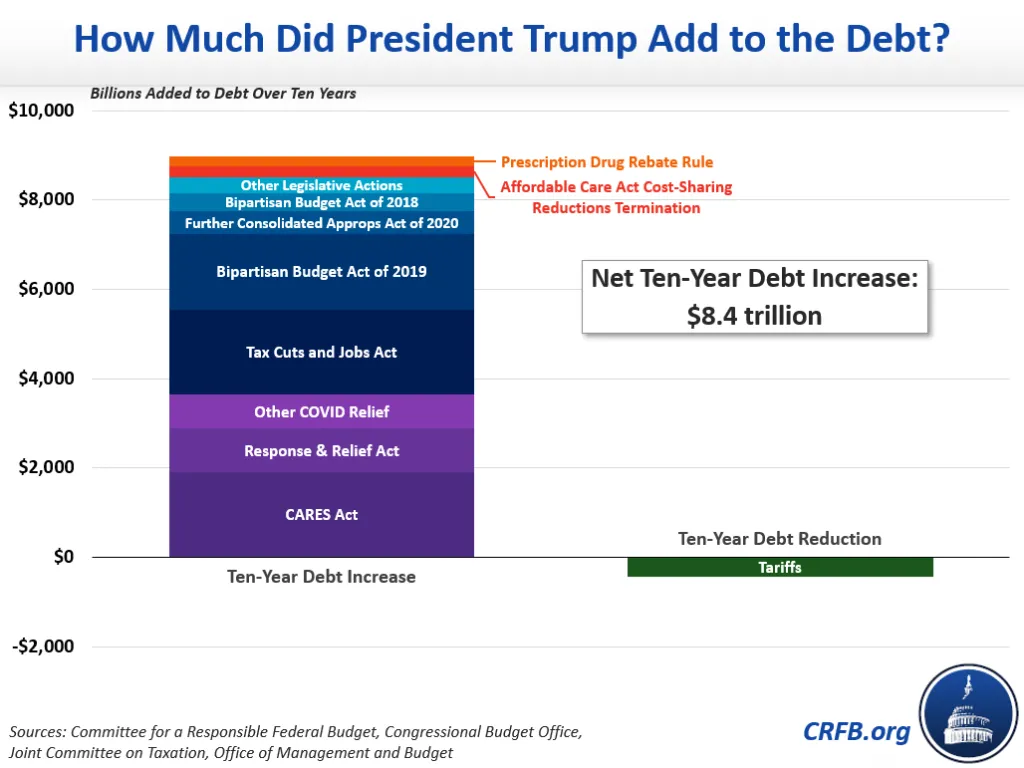Fact-Checking the 2024 State of the Union
In last night's State of the Union Address, President Biden made a number of claims related to the budget deficit. We've fact-checked three of those claims below:
- "I've already cut the deficit by over $1 trillion." False
- "I signed a bipartisan budget deal that will cut another trillion dollars over the next decade." True
- "The last Administration...added more to the national debt than any presidential term in American history." True
Claim #1: "I've already cut the deficit by over $1 trillion."
While the deficit has declined by over $1.0 trillion during the President’s term – from $2.8 trillion in Fiscal Year (FY) 2021 to $1.7 trillion in 2023 (and a projected $1.5 trillion in 2024), this is not because President Biden cut the deficit. If anything, it is in spite of it. As we explained when President Biden made a similar claim in his 2022 State of the Union Address, deficits fell from a COVID-relief-driven record high and still remain above pre-pandemic levels.
Indeed, more than the entirety of the fall in the deficit can be explained by COVID relief – enacted under both former President Trump and President Biden – expiring. We previously estimated that COVID-related spending fell by nearly $1.5 trillion between FY 2021 and 2022, explaining nearly the entire drop of the deficit. COVID relief has fallen even further through 2023 while deficits grew relative to 2022.
At $1.7 trillion ($2.0 trillion adjusted for student loan accounting issues), the deficit in FY 2023 was nearly twice as large as before the pandemic. And the laws and executive actions President Biden has signed have added to the deficit on net, not reduced it.
Our Rating: False.
Claim #2: "I signed a bipartisan budget deal that will cut another trillion dollars over the next decade."
The bipartisan Fiscal Responsibility Act (FRA), signed into law by President Biden on June 3, 2023, was estimated by the Congressional Budget Office to reduce deficits by $1.5 trillion through FY 2033. This includes about $250 billion of direct savings, mainly as a result of capping defense and nondefense discretionary spending in FY 2024 and 2025, nearly $1.1 trillion of additional savings from assuming real appropriations will remain at FY 2025 levels and grow with inflation, and almost $200 billion of lower interest costs.
Importantly, the legislation does not guarantee $1.5 trillion of savings – it relies on future appropriators to appropriate at the caps specified in the legislation. And certain "side deals" would reduce the bill’s net savings. Yet even with the originally-negotiated side deals (which have since been revised), we estimated the FRA will still save $1.0 trillion over a decade.
Our Rating: True.
Claim #3: "The last Administration...added more to the national debt than any presidential term in American history."
Federal debt held by the public grew by $7.2 trillion during the four years of the Trump Administration. This is more than under any presidential term in history, although debt-to-GDP did grow faster during President Obama's first term in office and during Franklin Delano Roosevelt's third term in office.
In terms of how much President Trump added to the debt, we previously estimated that he approved $8.4 trillion of new borrowing over ten years through various laws and executive actions. About half of this increase was COVID relief and three-quarters was bipartisan. This is certainly more than any prior President in dollar terms, and is at least more than any President in the last half century as a share of GDP (data limitations make it challenging to look back further).

Importantly, President Biden has also added substantially to the debt. Although we have not updated our previous estimate of how much debt he signed into law (or executive action), the amount is several trillion dollars in size but significantly smaller than President Trump’s $8.4 trillion. In addition, $5.6 trillion of debt has accumulated under President Biden’s term so far and that total will likely rise to $6.5 trillion by the end of his current presidential term.
Our Rating: True.


